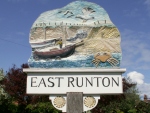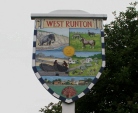East and West Runton - HistoryThe two villages of East and West Runton comprise the parish of Runton. A group under the auspices of the Parish Council, was formed three years ago to build a Parish Archive, in order to preserve the history of the villages. Information to add to these archives would be appreciated. An extract from the Doomsday book tells us that Runton was known as Rugutune in the 11th century. Rugutune had one Church. There were 24 households which was "quite large" including 12 bordars or smallholders and 7 freemen and 5 villagers and the total tax asessed was 1.4 geld units (quite small). 1.4 geld units would yield in value to the lord just over £1.00 There was 1 carucate (measurement of land for tax purposes) held by Bondi a freeman who was the overlord in 1066. the lord was Thorkil Hako. There was woodland for 12 pigs. In 1066 there were 60 sheep 1 horse, 5 head of cattle 5 pigs. Eight "sokemen" (a person with more land and obligations that the villagen) (peasants) oversaw 24 acres of land. There were also 1 Lord's plough team and 1.5 men's plough teams.
Coming forward a few years:
2014 is the Centenary year of the opening of the Montessori school in England 1914 in East Runton. Bertram Robert Hawker (1868-1952), Anglican clergyman, educationist and benefactor, was born on 29 March 1868 at Llandudno, Carnarvonshire, Wales, youngest of sixteen children of George Charles Hawker who had been born in London and become a politician and grazier in South Australia, and his wife Bessie, née Seymour, from Ireland. Bertram was educated at Glenalmond School, Perthshire, Scotland (1882-86), and at Trinity Hall, Cambridge (B.A., 1891; M.A., 1896). He worked with the poor in the East End of London and was made deacon in 1894. After serving as a curate at Stone, Kent, he was appointed honorary chaplain to the bishop of Adelaide in 1895. At St Peter's Cathedral, Adelaide, on 23 July 1896 Hawker married Constance Victoria, daughter of Sir Thomas Buxton the governor of South Australia. Returning to England, Hawker held curacies in Surrey and Cumberland before being ordained priest on 10 June 1900. For the next four years he was vicar at Isel, Cumberland, his last Church appointment. From 1908 he lived on the Buxton estate, Runton Old Hall, near Cromer, Norfolk. Hawker travelled to Rome in 1911 and called at Maria Montessori's casa dei bambine. Impressed with what he saw, he returned to England and set up a Montessori school near his home. Montessori's principles (to allow learning naturally through play and respect) were also adopted by the Kindergarten Union of South Australia, to which Hawker donated £500—£100 for its building fund and £400 to enable the principal Lillian De Lissa to study in Europe and the United States of America. In 1914 she stayed with Hawker and was opening speaker at the Montessori conference he organized at East Runton. To find out more about the Montessori philosophy go to :-http://www.montessori.org.uk
West Runton is a Geological Site of Special Scientific Interest (S.S.S.I.) and is of great significance in our understanding of the complex changes in climate, flora, and fauna of the Quaternary period, or 'lce Age'. For more than 170 years fossil remains of elephants, rhinos, deer and many other animals have been collected from what is known as the Cromer Forest Bed Formation, which includes the West Runton Freshwater Bed, exposed along the coasts of Norfolk and Suffolk. However, never before has an entire skeleton been reported from these well-searched deposits.
|
|
Welcome to: East and West Runton Parish Web Site. East and West Runton are villages in North Norfolk , UK


 In 1990, around 600,000 years after it died, the
remains of the West Runton Elephant was discovered after winter seas had eroded the cliffs
at West Runton, near Cromer, Norfolk, U.K. The huge pelvis was the first bone to be
revealed in the base of the cliff, and a year later many more bones were found. By 1992,
some 25 % of the skeleton had been recovered and plans were made to recover the remainder,
still buried beneath 20 metres of cliff, and to obtain evidence of the elephant's ancient
environment from the abundant associated plant and animal fossils.
In 1990, around 600,000 years after it died, the
remains of the West Runton Elephant was discovered after winter seas had eroded the cliffs
at West Runton, near Cromer, Norfolk, U.K. The huge pelvis was the first bone to be
revealed in the base of the cliff, and a year later many more bones were found. By 1992,
some 25 % of the skeleton had been recovered and plans were made to recover the remainder,
still buried beneath 20 metres of cliff, and to obtain evidence of the elephant's ancient
environment from the abundant associated plant and animal fossils.